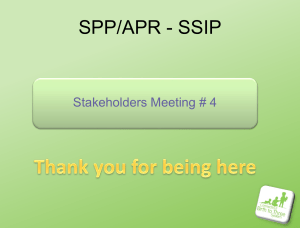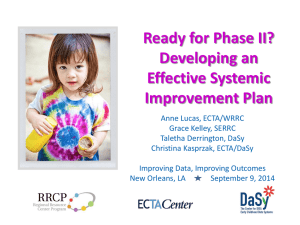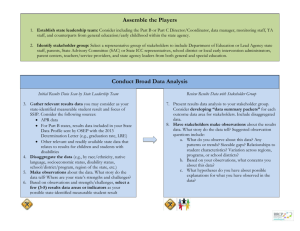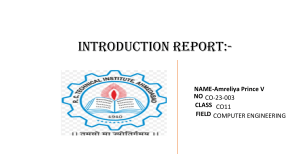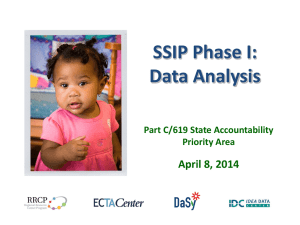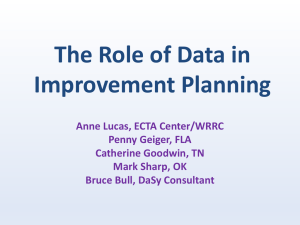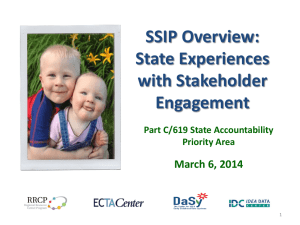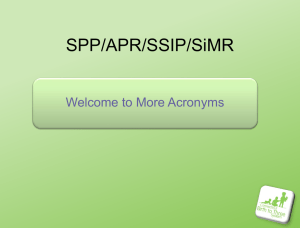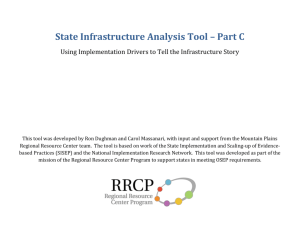Getting Ready for Phase II of the SSIP
advertisement
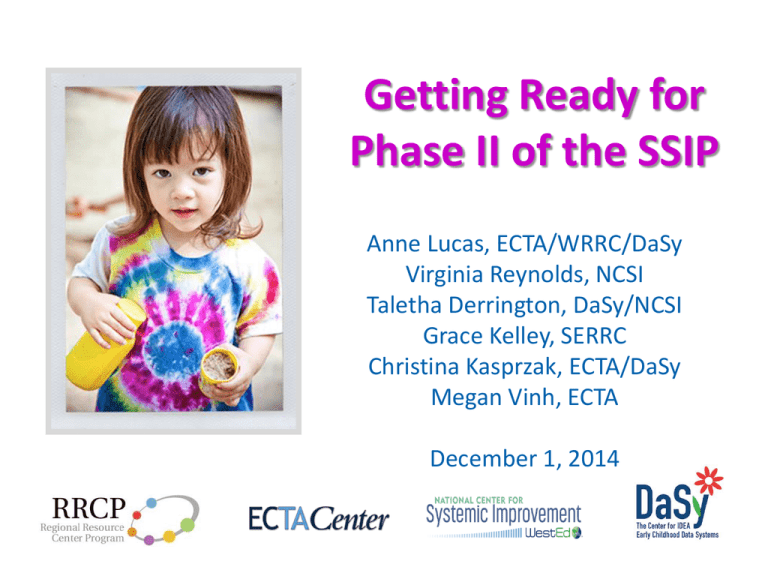
Getting Ready for Phase II of the SSIP Anne Lucas, ECTA/WRRC/DaSy Virginia Reynolds, NCSI Taletha Derrington, DaSy/NCSI Grace Kelley, SERRC Christina Kasprzak, ECTA/DaSy Megan Vinh, ECTA December 1, 2014 Webinar Outcomes • Understanding key requirements of Phase II • Understanding how Implementation Science principles might be used in developing an improvement plan • Understanding what constitutes a good improvement plan (or strategic plan) • Introducing the concept of evaluation 2 OVERVIEW OF PHASE II 3 Proposed SSIP Activities by Phase Year 1 - FFY 2013 Delivered by Apr 2015 Year 2 - FFY 2014 Delivered by Feb 2016 Years 3-6 Phase I Analysis Phase II Development Phase III Evaluation and Implementation • Data Analysis; • Description of Infrastructure to Support Improvement and Build Capacity; • State-identified Measureable Result; • Selection of Coherent Improvement Strategies • Theory of Action • Multi-year plan addressing: • Infrastructure Development; • Support EIS Program/LEA in Implementing Evidence-Based Practices; • Evaluation Plan • Reporting on Progress including: • Results of Ongoing Evaluation • Extent of Progress • Revisions to the SPP FFY 2015-18 Feb 2017- Feb 2020 4 Phase II - Improvement Plan: Infrastructure Development Infrastructure development includes: • Improvements to infrastructure to better support EIS programs/LEAs to scale up evidence-based practices to improve SiMR – Who will implement infrastructure changes – Resources needed – Expected outcomes – Timelines 5 Phase II - Improvement Plan: Infrastructure Development Infrastructure development includes (cont’d): • Identify steps to further align/leverage current improvement plans/initiatives • How to involve other LA/SEA offices and other agencies 6 Phase II - Improvement Plan: Evidence-based Practices Support for implementing evidence-based practices includes: • Activities supporting implementation of strategies including: – Communication strategies and stakeholder involvement – How identified barriers will be addressed – Who will be in charge of implementing – How activities will be implemented with fidelity 7 Phase II - Improvement Plan: Evidence-based Practices • Activities include (cont’d): – Resources that will be used – How expected outcomes of strategies will be measured – Timelines • How multiple offices/other state agencies will be involved to support LEAs/EIS programs in scaling up and sustaining evidence-based practices implemented with fidelity 8 Phase II - Improvement Plan: Evaluation • The plan to evaluate implementation includes: – Short-term and long-term objectives to measure implementation and impact on results – Long-term objectives for children exiting Part C • Plan must be aligned with: – Theory of Action – Other components of SSIP 9 Phase II - Improvement Plan: Evaluation • Plan must include: – How stakeholders will be involved – Methods to collect and analyze data on activities and outcomes – How State will use evaluation results to: • • • • Examine effectiveness of implementation plan Measure progress toward achieving intended outcomes Make modifications to plan How results of evaluation will be disseminated 10 IMPLEMENTATION SCIENCE 11 Some Ideas to Consider The SSIP cannot thrive in a vacuum - EIS/special education state agencies will not be successful if the SSIP is disconnected from the agency’s focus and work. 12 Some Ideas to Consider The SSIP should be aligned to and integrated with other initiatives in the state. – Supports leveraging of resources - greater influence – Prevents duplication of efforts – Builds momentum and capacity – Improves results 13 Implementation Science Active Implementation Frameworks WHO WHAT HOW WHEN Teams HOW Usable Interventions Drivers Stages Cycles http://sisep.fpg.unc.edu/ https://unc-fpg-cdi.adobeconnect.com/_a992899727/ai-lesson-quickstart/ 14 Consider Implementation Science: Implementation Drivers Performance Assessment (Fidelity) Coaching Systems Intervention Training Facilitative Administration Decision Support Data System Selection Leadership © Fixsen & Blase, 2008 Technical Adaptive 15 The Hexagon An EBP Exploration Tool The “Hexagon” can be used as a planning tool to evaluate evidencebased programs and practices during the Exploration Stage of Implementation. • Academic & socially significant Issues • Parent & community perceptions of need • Data indicating need Capacity to Implement • • Staff meet minimum qualifications Able to sustain Imp Drivers • Financially • Structurally Buy-in process operationalized • Practitioners • Families • Download available at: Need in local programs, state www.scalingup.org/tools-and-resources NEED Fit with current Initiatives • Local program, state priorities • Organizational structures Community values CAPACITY FIT EBP: 5 Point Rating Scale: High = 5; Medium = 3; Low = 1. Midpoints can be used and scored as a 2 or 4. High Med READINESS Low Fit Resources and supports for: Readiness for Replication • • • • • • Need RESOURCES Qualified purveyor Expert or TA available Mature sites to observe Several replications How well is it operationalized? Are Imp Drivers operationalized? EVIDENCE Resource Availability • • • • • • • Curricula & Classroom Technology supports (IT dept.) Staffing Training Data Systems Coaching & Supervision Administration & system Evidence Evidence Readiness for Replication Capacity to Implement •Outcomes – Is it worth it? •Fidelity data •Cost – effectiveness data •Number of studies •Population similarities •Diverse cultural groups •Efficacy or Effectiveness Total Score 16 © National Implementation Research Network 2009-2012 Adapted from work by Laurel J. Kiser, Michelle Zabel, Albert A. Zachik, and Joan Smith at the University of Maryland Consider Implementation Science: Implementation Drivers Resources 1. Active Implementation Hub: http://implementation.fpg.unc.edu/ 2. ECTA Implementation Processes: http://ectacenter.org/implementprocess/implementprocess.asp 3. Hexagon tool: www.scalingup.org/tools-and-resources 4. National Implementation Resesarch Network: http://nirn.fpg.unc.edu/ 5. Implementation Drivers: Assessing Best Practice http://implementation.fpg.unc.edu/sites/implementation.fpg.unc.edu/files/r esources/NIRN-Education-ImplementationDriversAssessingBestPractices.pdf 17 Planning is something you do so when you do something it is not all messed up Christopher Robin to Winnie the Pooh DEVELOPING A GOOD SSIP PLAN 18 What Results will Your Plan Achieve? Governance Result: Finance Quality Standards Implementation of effective practices Good outcomes for children with disabilities and their families Personnel / Workforce Accountability & Quality Improvement Data Systems 19 Theory of Action Specific Focus for Improvement including Measurable Child and/or Family Result Data Analysis • Infrastructure Assessment In-depth Analysis Related to Focus Area • Data about Local Contributing Factors • In-depth Analysis Related to Focus Area • Data about Local Contributing Factors Primary Concern(s)/Focus(es) Broad Data Analysis Broad Infrastructure Assessment • Analysis of data to identify areas lower performance and results for children/families; • Qualitative and Quantitative data • Analysis: current initiatives; current strengths and challenges of system components • Qualitative and Quantitative data Getting Started/Preparation What is Strategic Planning ? • Planning is an organizational management activity that is used to: Set priorities Focus energy and resources Ensure that employees and other stakeholders are working toward common goals Establish agreement around intended outcomes/results 21 What is a strategic plan? • a document used to communicate with the organization the organizations goals, the actions needed to achieve those goals and all of the other critical elements developed during the planning exercise 22 SSIP Plan Focus • Uses the data and infrastructure analyses, improvement strategies and theory of action • Details how the State will support and build the capacity of EIS programs / providers to implement practices that lead to the SIMR • Articulates how you will evaluate progress of implementation and the outcomes and impact of your work. 23 Why an SSIP Plan? • Your SSIP plan will define how you will achieve measureable results for infants and toddlers by strengthening your infrastructure, and implementing evidenced based practices. 24 Why an SSIP Plan? Your plan will define how you will implement SSIP, including: Activities, steps and resources necessary to achieve the improvement strategies. The timelines for beginning and completing the improvement strategies Strategies Activities with timelines 25 Theory of Action What are the issues: What are our activities: What are our desired outcomes: • State System Level • State System Level • Local System Level • Direct Supports • Practices/Services • Children and Families • Local System Level • Direct Supports • Practices/Services • Children and Families if • State System Level • Local System Level • Direct Supports • Practices/Services • Children and Families then Theory of Action 26 Back Begin with the End in Mind What are the desired results or outcomes for children and/or families ? How do we achieve the SiMR 27 What Activities Support the Strategies and Implement the Theory of Action? What activities What activities What activities What activities What are the will be will be will be will be desired results implemented to implemented to implemented to implemented to or outcomes for ensure state ensure local ensure ensure children and/or system systems effective practitioners families ? supports local support training, TA, have relevant systems and practitioners? coaching and knowledge implementation other and skills to of desired supports implement practices? related to aligned desired practices? practices ? State Supports Local supports Professional Development Core Competencies Achieve the SIMR 28 Considerations for Strategies and Activities Build capacity at all levels of the system Build on the strengths of the infrastructure and address the weaknesses Align with key initiatives and current improvement plans Connect and reflect the root causes impacting the SiMR Identify communication strategies (to facilitate buy in) and stakeholder involvement 29 The Hexagon An EBP Exploration Tool The “Hexagon” can be used as a planning tool to evaluate evidencebased programs and practices during the Exploration Stage of Implementation. Download available at: www.scalingup.org/tools-and-resources Need in local programs, state • Academic & socially significant Issues • Parent & community perceptions of need • Data indicating need Capacity to Implement • • Staff meet minimum qualifications Able to sustain Imp Drivers • Financially • Structurally Buy-in process operationalized • Practitioners • Families • NEED Fit with current Initiatives • Local program, state priorities • Organizational structures Community values CAPACITY FIT EBP: 5 Point Rating Scale: High = 5; Medium = 3; Low = 1. Midpoints can be used and scored as a 2 or 4. High Med READINESS Low Fit Resources and supports for: Readiness for Replication • • • • • • Need RESOURCES Qualified purveyor Expert or TA available Mature sites to observe Several replications How well is it operationalized? Are Imp Drivers operationalized? EVIDENCE Resource Availability • • • • • • • Curricula & Classroom Technology supports (IT dept.) Staffing Training Data Systems Coaching & Supervision Administration & system Evidence Evidence Readiness for Replication Capacity to Implement • • • • • • • Outcomes – Is it worth it? Fidelity data Cost – effectiveness data Number of studies Population similarities Diverse cultural groups Efficacy or Effectiveness Total Score © National Implementation Research Network 2009-2012 Adapted from work by Laurel J. Kiser, Michelle Zabel, Albert A. Zachik, and Joan Smith at the University of Maryland Develop Activities: • Improvement Activities are the specific actions that implement the strategy and lead to the SIMR • Activities are SMART: –Specific –Measurable –Attainable –Realistic –Timed 31 What the plan might look like Vision Mission Program/Initiative Goals SSIP Plan State Identified Measureable Result Theory of Action Targets (five years) Improvement Strategies Activities (short and long term) Timelines (five years) Evaluation 32 Set Targets • Targets - specific numbers you intend to meet in order to achieve the goals over the time period of the SSIP • They can be incremental increases or maintain progress 33 Short and Long Term The short and long term activities are defined steps that help achieve the goal (SIMR): • Short Term – incremental steps with shorter timeframes that move an organization toward their goals usually accomplished in 1-3 years • Long Term - Performance measures to be achieved over a period of five years or more 34 Resources For Strategic Planning • http://ctb.ku.edu/en/table-of-contents/structure/strategicplanning/create-objectives/main • http://www.hfrp.org/publications-resources/browse-ourpublications/strategic-planning-process-steps-in-developing-strategicplans • http://balancedscorecard.org/Resources/Strategic-Planning-Basics 35 And on to Evaluation • You've got to be very careful if you don't know where you're going, because you might not get there.” Yogi Berra, Former Yankees catcher 36 EVALUATION Evaluating the Implementation • Built into the plan from the beginning • Based on your theory of action • Based on data that informed the plan development • Formative data and summative data • Evidence to show progress 38 Evaluation at All Levels Governance Result: Finance Quality Standards Implementation of effective practices Good outcomes for children with disabilities and their families Personnel / Workforce Accountability & Quality Improvement Data System 39 Thank you! • • • • • Anne Lucas, anne.lucas@unc.edu Grace Kelley, gkelley3@cox.net Taletha Derrington, taletha.derrington@sri.com Christina Kasprzak, christina.kasprzak@unc.edu Virginia Reynolds, vreynol@wested.org 40
